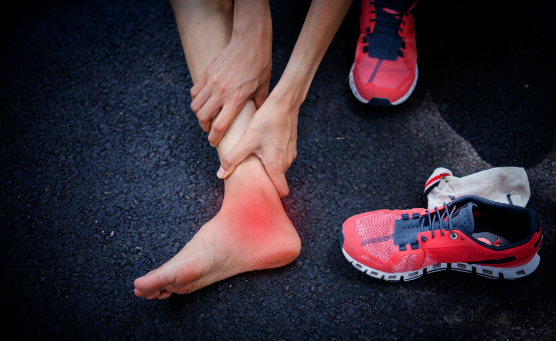This is for information only and not intended as strict medical advice. We suggest always having an assessment with a trained professional who can help you. If you wish to do this through one of our team, click the link below to book an appointment at one of our branches throughout Scotland.
Pain on the inside of the shins during activity can be frustrating, debilitating and well… painful of course.
First, it is important to understand the different types and causes of shin pain to arrive at the solution.
If you want to jump straight to the solutions, scroll down to the end.
Medial tibial stress syndrome (MTSS)
MTSS can be diagnosed as pain on the inside of the shin bone with pain usually felt 5-10cm above the inside ankle bone.
Pain can be caused by the muscles on the inside of the leg pulling on the connective tissue attached to the bone. Or, it can be impact forces on the bone itself due to foot position while walking and running. This pain often builds up during activity and stops with rest.
If you have an arch that flattens excessively (also known as navicular drop) when running, this has been shown as a risk factor of MTSS (1).
Managing your activity is very important for another reason. Keep reading and you’ll find out why.
Tibialis posterior tendonopathy
The tibialis posterior tendon runs along the inside of the shin and behind the inside ankle bone before inserting into the arch of your foot. As the foot rolls in (pronates) the tibialis posterior activates to provide stability and control to the foot’s arch.

If the foot pronates for longer than necessary, or at a higher force than the muscle can control, over time this tendon can become painful.
Pain may be present first thing in the morning as well as building up during a longer walk or run.
Anterior Shin Splints
This pain can feel like a tightness or an ache in the muscle of the shin when walking or running. It is usually caused by the main ankle dorsiflexor muscle, Tibialis Anterior, which flexes the ankle up.
If your Achilles tendon or calf is tight, this muscle has to work harder to bring your foot up and can lead to discomfort.
Tibia Stress Fractures
A stress fracture will be very painful at a precise point on your shin and even walking one step may be painful. If you suspect you have a stress fracture, please contact your doctor or the hospital so they can guide your treatment.
You will need to stop the activities that aggravate the pain and undergo a period of rest which may also include the use of a crutch or moonboot.
Exertional compartment syndrome
Exertional compartment syndrome is characterised by a burning, aching or pressure feeling in the front and outer shin. This pain and sensation can appear after a similar distance or intensity of running which gradually worsens with further activity (2). Pain usually subsides with rest.
There can be associated tightness and feeling of pressure within the muscle as well as weakness in some cases. If you feel any of these symptoms, it is recommended to see your GP that the relevant tests can be carried out.
3 key tips for treatment to get you back at it
What gets measured, gets managed
Have you heard this saying before? In the context of shin pain, it is really important to understand how much you can do before the pain starts.
Use distance, time or number of steps as key stats to inform your activity level.
Work with this number to gauge how much exercise your shins can manage. The aim is to exercise as much as you can within a pain free range, not going beyond that.
As the weeks progress, gradually increase your activity level from your initial measurement. You may push into the realms of pain as you try to progress which is completely normal.
If this happens, reset and readjust your activity goal for that week.
What we have just described is a concept called Load Management which is so important when dealing with activity-induced shin pain. If you would like to learn more about the principle of load management, head over to our website and look at our blog post on this topic
Get a biomechanical assessment
A biomechanical assessment will help you to figure out if the way you are running or walking is causing your shin pain.
Our team of experts are highly trained to guide you through a thorough examination and if necessary, can provide a treatment plan to get you out of pain.
For more information you can visit our website to read about our biomechanical assessment services.
This assessment will look at how you stand, walk and run with an in-depth history taken to truly understand your problem.
We then look to pinpoint which structure in your shin is giving you the problem and a plan can be made together to find the solution!
Resting may take the pain away momentarily but we need to get to the source of the problem.
Book your appointment here at any of our locations across Scotland.
Change your cadence or step width
Some studies have shown that shortening your stride length and increasing the number of steps you take (cadence) reduce the forces on the lower limb when running (3).
Another tip is to widen your step width (4). You can do this by imagining you are running on train tracks!
If you don’t know where to start, a gait analysis would be the best place.
Our team of expert orthotists and podiatrists are always on hand to get you back doing what you love.
References
- Menéndez C, Batalla L, Prieto A, Rodríguez MÁ, Crespo I, Olmedillas H. Medial Tibial Stress Syndrome in Novice and Recreational Runners: A Systematic Review. Int J Environ Res Public Health. 2020 Oct 13;17(20):7457. doi: 10.3390/ijerph17207457. PMID: 33066291; PMCID: PMC7602098.
- Tucker AK. Chronic exertional compartment syndrome of the leg. Curr Rev Musculoskelet Med. 2010 Sep 2;3(1-4):32-7. doi: 10.1007/s12178-010-9065-4. PMID: 21063498; PMCID: PMC2941579.
- Luedke LE, Heiderscheit BC, Williams DS, Rauh MJ. Influence of Step Rate on Shin Injury and Anterior Knee Pain in High School Runners. Med Sci Sports Exerc. 2016 Jul;48(7):1244-50. doi: 10.1249/MSS.0000000000000890. PMID: 26818150.
- Brindle RA, Milner CE, Zhang S, Fitzhugh EC. Changing step width alters lower extremity biomechanics during running. Gait & posture. 2014 Jan 1;39(1):124-8.
